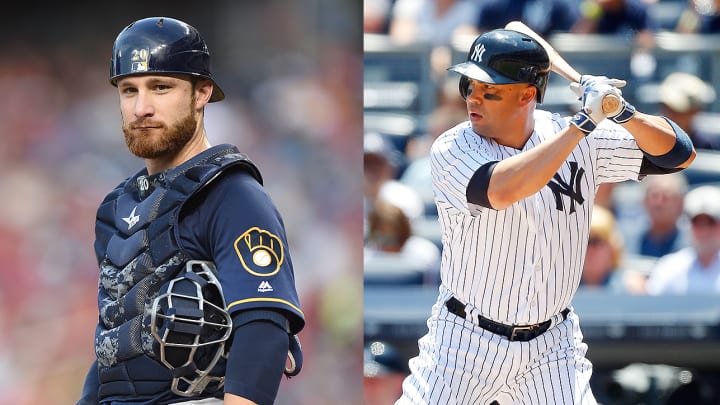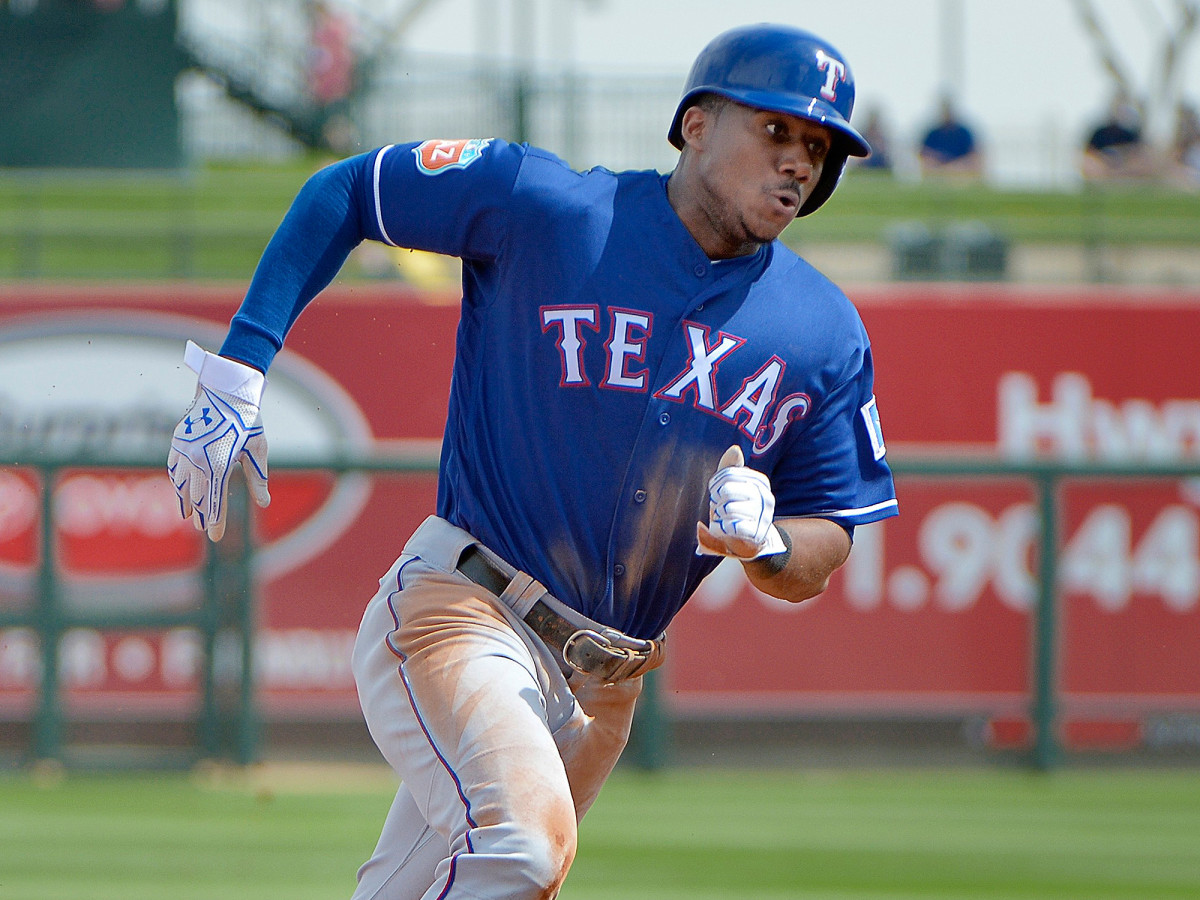Rangers go all-in with deadline acquisitions of Lucroy, Beltran

In the final 90 minutes before Monday’s trading deadline, the Rangers dug into their considerable stable of prospects to land the two biggest bats moved in the past month, namely Yankees outfielder/designated hitter Carlos Beltran and Brewers catcher Jonathan Lucroy; they also got righty reliever Jeremy Jeffress from Milwaukee. While Beltran will be a free agent this winter, the two former Brewers have years of club control remaining, helping to justify a high cost in prospects. Texas gave up three in each deal, including first round draft picks from 2012, '14 and '15, though the Rangers did not move either Joey Gallo or Jurickson Profar, two highly-sought infielders whom they can’t regularly fit into their starting lineup.
The 30-year-old Lucroy was nearly traded to the Indians on Sunday but invoked his partial no-trade clause to veto the deal; unlike the Indians, the Rangers weren't among the eight teams to which he could block a trade. A strong hitter (.299/.359/.482 with 13 homers and a 122 OPS+) and a good defender, Lucroy should provide a substantial upgrade on the work done by Robinson Chirinos, Bobby Wilson, Bryan Holaday and Bret Nicholas on both sides of the ball. That group, destabilized by Chirinos’s broken forearm in April (he's since returned), has hit a combined .233/.287/.422. That group has also beeen roughly six runs below average in pitch framing via Baseball Prospectus’ framing stats and thrown out just 22% of would-be base thieves; Lucroy has been roughly average in framing—he was among the game’s elite from 2012 to '14—and thrown out 29%. Once the dust settled on the day’s deals, the Rangers designated both Wilson and Holaday (who was on the disabled list) for assignment, leaving Chirinos as Lucroy's primary backup.
• Trade deadline winners and losers: Rangers, Yankees come out on top
What made Lucroy a particularly hot commodity is his club-friendly contract: He’s making just $4.25 million this year, with a no-brainer $5.25 million club option for next year. He had asked the Indians to decline that option so that he could reach free agency this winter, hitting the market heading into his age-31 season. The Mets were reported as having made a run at Lucroy with a deal centered around catcher Travis d'Arnaud and outfielder Brandon Nimmo, with a desire for a third MLB-ready player as well, but they bowed out of the running sometime on Monday.
The 39-year-old switch-hitting Beltran, who's making $15 million this season, drew deadline interest from the Astros, Indians and Red Sox as well as the Rangers. He had been the Yankees' strongest hitter this year, batting .304/.344/.546 with 22 homers and a 135 OPS+; his batting average ranks ninth in the league, his slugging percentage fourth. His days as a centerfielder are long gone, and he's shaky as a rightfielder, to say the least, accumulating -28 Defensive Runs Saved in his 2 2/3 seasons with the Yankees. But as a full-time DH, he can't help but provide a massive upgrade on the .223/.305/.349 showing the Rangers have gotten from their group, primarily Prince Fielder, who last week underwent season-ending neck surgery. With Shin-soo Choo due back from the disabled list on Thursday after missing time due to back stiffness, Beltran’s exposure in the outfield is likely to be minimal. Both he and Lucroy should help squeeze out even more runs from an offense that ranks fifth in the AL at 4.76 per game. Via the Dallas Morning News’sEvan Grant, the Yankees are sending $2.5 million to cover roughly half of Beltran's remaining salary.
• Jay Bruce a strange fit with Mets, who still face long playoff odds
The 28-year-old Jeffress, a 2006 first-round pick, didn't stick in the major leagues until last season but has done a solid job as the Brewers' closer this year, saving 27 games and pitching to a 2.22 ERA with 7.1 strikeouts per nine in 44 2/3 innings. He works primarily with a sinker/curve combination, with the fastball averaging 96.7 mph, according to Brooks Baseball. He's got a 57.5% ground-ball rate and has yielded just 0.4 homers per nine, making him a welcome addition to a bullpen yielding AL worsts in homers per nine (1.4), ERA (4.78) and FIP (4.85), whether or not he supplants closer Sam Dyson. Jeffress will be arbitration eligible for the first time this winter, so he's under club control through 2019.
While the slugging Gallo was reported to be the centerpiece of the Brewers' return until about 15 minutes before the deadline, he was not part of the final deal. In exchange for Lucroy and and Jeffress, the Brewers received outfielder Lewis Brinson and righty Luis Ortiz—their second- and fourth-ranked prospects coming into the season, according to Baseball America (third and fifth, per ESPN and Baseball Prospectus)—plus a player to be named later.
The 22-year-old Brinson, the 29th pick of the 2012 draft out of a Fort Lauderdale high school, is a centerfielder who came into the season ranked 15th on BP’s Top 101 prospect list, 16th on those of BA and MLB and 32nd on that of ESPN. He has scuffled at Double A Frisco, however, hitting just .237/.280/.431 and missing three weeks in June due to a left (nonthrowing) shoulder strain; his stock slipped to number 30 on BA's midseason list. Via ESPN's Keith Law, “Brinson is an elite defensive centerfielder who doesn’t have to hit much to have value in the majors and who has All-Star potential if he hits enough to get to his plus-plus power.”

The 20-year-old Ortiz was the 30th pick of the 2014 draft out of a California high school, a supplementary pick received via the departure of Nelson Cruz. He came into the year ranked between 64th (BA) and 79th (ESPN) on the major prospect lists and 74th on BA's midseason list, and began his season at Class A High Desert before moving up to Frisco; at the two stops, he's pitched to a 3.48 ERA with 8.3 strikeouts and 1.7 walks per nine in 67 1/3 innings. A burly 6'3", 230 pounds, he has a fastball that sits 93–95 mph and can touch 97, with excellent command, and a bat-missing slider that has deception thanks to its late tilt. His changeup shows signs of being at least average, but it's not there yet; if he can develop it into a quality third pitch, his ceiling is as a No. 2 or 3 starter. Beyond his weight, the main concerns voiced about him are with regards to his durability, as he's missed time in the past two seasons due to forearm tightness (2014) and elbow tendonitis ('15).
• Giants grab pair of lefties in Moore, Smith in move for 2016 and beyond
Throw in a third prospect, and that appears to be a stronger return for the Brewers than they would have received from the Indians, at least in terms of top-100 prospects. The four-player package coming from Cleveland was reportedly headlined by Class A catcher Francisco Mejia, 70th on BA's midseason list.
The three pitchers the Rangers sent to the Yankees are righties Dillon Tate, Nick Green and Erik Swanson. The 22-year-old Tate was the No. 4 pick of the 2015 draft out of UC-Santa Barbara, signed for a $4.2 million bonus. He came into the year ranked as high as 36th (MLB) and as low as 69th (BA) on the major lists but did not make the latter's midseason list, as he was knocked around for a 5.12 ERA with 3.7 walks and 7.6 strikeouts per nine in 65 innings at Class A Hickory. A lanky 6'2" and 165 pounds, Tate has shown a 92–96-mph fastball that can reach 98 as well as a hard slider that flashes plus-plus; his changeup is a work in progress, and his upside is as a mid-rotation starter.
Tate is a long ways off from that, however. As Grant noted, he has “a lot of moving parts to his delivery” that have caused him to struggle with command and control. He's also pitched through some leg issues that have cost him velocity; via BA's J.J. Cooper, in Tate's worst starts this season, his velocity has slipped into the high 80s. He'll be a project for the Yankees' organization, but a high-end one and the second top-five draft pick added to the organization in as many days, after the Indians' Clint Frazier, who arrived in the Andrew Miller trade. As Cooper added, he's an “excellent buy low with risk” for the Yankees; when you consider that Beltran would have brought back a compensation pick around No. 30, he's an upgrade even if his being chosen at No. 4 was an overdraft.
• Yankees build for future as Andrew Miller trade nets strong return
The 22-year-old Swanson is a 6'3", 220-pound righty who was drafted in the eighth round out of Iowa Western in 2014. At Hickory, he's pitched to a 3.43 ERA with 8.6 strikeouts per nine in 81 1/3 innings after throwing just 15 1/3 innings in last year due to a flexor strain. Law described him as “an arm-strength guy who's been up to 98 but is 22 in low A and has been facing a lot of younger competition.” WFAA’s Kate Morrison noted that he has “an advanced feel for pitching,” and BP's Adam McInturff reported that he throws a heavy, sinking 90–94-mph fastball that touched 95–96, with a fair slider and a tumbling changeup.
Green (not to be confused with the well-traveled utility infielder of the same name) is a 21-year-old righty listed at 6'1" and 165 pounds and is a seventh-round 2014 pick out of Indian Hills Community College in Iowa; he was drafted by the Yankees in the 35th round in 2013, so obviously, they've been keeping tabs on him. In seven starts for Class A Spokane, he's been touched for a 4.98 ERA in 34 1/3 innings but has yet to allow a homer and has whiffed 11.5 per nine. Via Morrison, he “possesses a plus fastball and curveball, if little-to-no idea what he’s doing with them.”
Even if Swanson and Green wind up in the bullpen, they could be useful parts at the big league level, and they add to the Yankees’ system remake that’s taken place over the past week with the trades of Miller, Aroldis Chapman and Ivan Nova. As for the Rangers, while they didn’t get the starting pitching help they desired, they’ve fortified their lineup and defense, held onto their ready youngsters and essentially gone all-in in an attempt to return to the postseason for the fifth time in seven seasons, with a leg up on next year as well.
